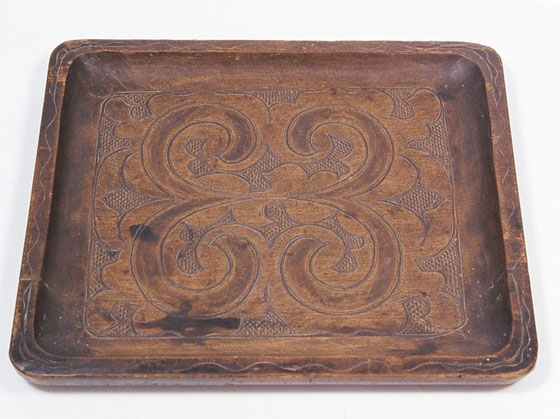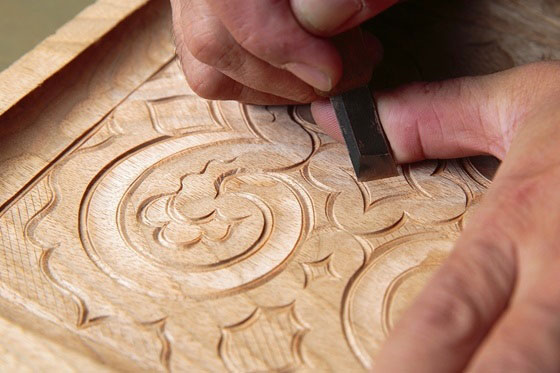 Photo:Nibutani folk handicraft association
Photo:Nibutani folk handicraft association
- Wood, bamboo crafts
- Hokkaido
Nibutani carved wooden tray Nibutani ita
Cultural heritage of the Ainu that express
the wooden texture and traditional patterns
Description
What is Nibutani carved wooden tray ?
Nibutani Carved Wooden Trays (called Nibutani ita in Japanese) are produced in Biratori, Hokkaido. The origin of the town name, is an Ainu language word for cliff, pirauturu. This craft is known for its patterns like a spiral pattern called moreunoka, a thorn-shaped pattern called aiushnoka, and an eye-shaped pattern called shiknoka. All three words originate from Ainu and the designs are combined to express a beautiful Ainu appearance. Also, this craft always has carved scale shapes called ramramnoka which fill the space between other patterns. In the past, the trays were used daily by the Ainu people, and today, they are valued as a delicate craft by craftsmen.
History
 Photo:Nibutani folk handicraft association
Photo:Nibutani folk handicraft association
Although Nibutani Carved Trays are assumed to be a tray because of its shape, an Ainu language folk tale, Uepekere, mentions them as a plate on which food was served. Blades were an essential item for Ainu life, and being able to use the blades skillfully gave men social status. For this reason, an Ainu man would put all his energy into making a carved wooden item for a woman who he liked, when they reached marriageable age. With this background, the Ainu carved wooden items, including Nibutani ita, have long been used as expensive gifts, presents for exchange, or commercial items. Between the years of 1854-1859, it was recorded that Nibutani ita was among the gifts to the government of the Matsumae domain (now Hokkaido prefecture). In 1873, Nibutani Carved Trays were exhibited at the Vienna World Exposition. The trays were designated as a traditional national craft in March 2013. This was the first time for a craft made in Hokkaido to be designated as a traditional national craft.
Production Process
 Photo:Nibutani folk handicraft association
Photo:Nibutani folk handicraft association
- 1. Making the base of the tray
Wooden boards made from Japanese Judas trees or walnut trees grown in Hokkaido are used for Nibutani ita. The wooden boards are dried for three years before being used. First, the boards are roughly carved, and the depth of the tray is adjusted. Next, the base of the tray is carved carefully with a knife called kawadachi bocho which has a flat spatula shaped blade at the top, to smoothen the surface and make the depth of the tray even. When the wooden boards are roughly carved, a machine called senban that carves while rotating cannot be used for the square Nibutani ita, so a square tray takes longer to produce compared to a round tray.
- 2. Finishing the back
As Nibutani ita is a wooden product, the back also has to be treated carefully. The edges are neatly rounded. This process determines the pleasant feel of the product when it is finished and held in one's hand.
- 3. Carving patterns
The pattern on the surface of the tray is designed. The design of Nibutani ita is a combination of a spiral pattern, moreunoka, meaning bending gently, a thorn-shaped pattern, aiushnoka, and an eye-shaped pattern, shiknoka. The balance and composition of these patterns determine the look of the tray. When the design is decided, the outline of the pattern is carved using a V-shaped chisel. Then, the tray is deeply carved with a gouge to give a three-dimensional effect. Chisels are used today to carve the delicate lines. However, in the days of the Ainu, the whole carving process was done with only one small knife, which is why the ancient Nibutani ita had plain but strong lines.
- 4. Double line carving
The thorn-shaped pattern, aiushnoka is often used as the main pattern for Nibutani ita. The inner side of the main pattern is carved when carving double lines. The expression of Nibutani ita is enhanced by the three-dimensional effect of the double line carving.
- 5. Scale line carving
Before carving ramramnoka (scale patterns) between the mourenoka and shiknoka patterns, lines for the scale patterns are carved with a chisel called into, which is used to carve signature stamps. When these lines are carved, the wood grain has to be in a lengthwise direction. Ramramnoka patterns are often used between patterns for Nibutani ita.
- 6. Lifting up scales
The squares carved in Process 5 are lifted up one by one to make the ramramnoka scale shapes. When the scale shape is made, the scales are lifted towards the center from the left and right. Half of the squares are carved in this process. The expression unique to Nibutani ita is determined by the texture of the ramramnoka carvings.
- 7. Finishing
Details are finely and carefully adjusted to finish the Nibutani ita.
Facility Information
Biratori Ainu Bunka Joho Center
-
Address
-
Tel.+81-1457-2-3299
-
Business Hours9am to 5pm
-
Website
Other Wood, bamboo crafts
- Hakone wood mosaic
- Iwayado traditional chest
- Kaba cherrybark woodcrafts
- Odate bentwood
- Inami wood carvings
- Matsumoto furniture
- Beppu bamboo crafts
- Edo wood joinery
- Ichii woodcarvings
- Suruga bamboo crafts
- Edo bamboo fishing rods
- Kishu bamboo fishing rods
- Kamo traditional chest
- Kyo wood joinery
- Miyakonojo archery bows
- Osaka carved wooden panel
- Miyajima woodwork
- Nibutani carved wooden tray
- Okuaizu Basketry
- Echizen traditional chest
- Kasukabe traditional paulownia chest
- Katsuyama bamboo crafts
- Osaka karaki wood joinery
- Takayama tea whisks
- Toyooka wicker crafts
- Akita cedar tubs and barrels
- Nagiso woodturning
- Kishu traditional chest
- Nagoya traditional paulownia chest
- Osaka bamboo screens
- Osaka-senshu traditional paulownia chest
- Sendai traditional chest

































































































































































































































































































